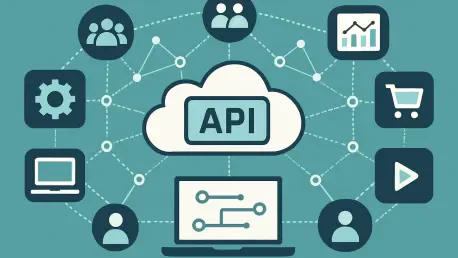In today’s rapidly evolving digital landscape, enterprises are grappling with the challenge of managing APIs across diverse environments—cloud, on-premises, and edge—while ensuring scalability and security. A staggering statistic reveals that over 80% of organizations now operate in multi-cloud or hybrid setups, creating a pressing need for robust API management solutions that can handle such complexity. Federated API Management emerges as a transformative architectural pattern, promising to address these challenges by separating control and execution planes for enhanced governance and performance.
Core Principles and Relevance in Modern IT
Federated API Management is defined by its ability to centralize governance while distributing runtime execution across multiple gateways. This approach allows organizations to define policies, versioning, and security measures in a single control plane, while APIs are deployed closer to end-users or services for optimal performance. Its emergence aligns with the growing adoption of hybrid and multi-cloud environments, where traditional, monolithic API management struggles to keep pace with dynamic scalability needs.
The significance of this technology in enterprise IT cannot be overstated. It tackles critical demands for resilience by ensuring that failures in one gateway do not impact others, while also reducing latency through localized deployments. Furthermore, it supports operational independence for distributed teams, making it a cornerstone for businesses aiming to maintain agility in complex API ecosystems.
Detailed Analysis of Features and Performance
Centralized Governance with WSO2 API Manager
At the heart of Federated API Management lies the control plane, exemplified by platforms like WSO2 API Manager. This tool serves as the central hub for designing, securing, and monitoring APIs, ensuring consistent policy enforcement across diverse environments. Its robust lifecycle management capabilities allow enterprises to version APIs seamlessly, maintaining control over updates and deprecations without disrupting operations.
Beyond policy enforcement, WSO2 API Manager offers comprehensive analytics and monitoring features. These enable organizations to track API usage patterns, identify bottlenecks, and enforce compliance with organizational standards. Such centralized oversight is vital for maintaining security and governance in setups where APIs are deployed across multiple regions or cloud providers.
Distributed Execution via AWS API Gateway
On the execution side, AWS API Gateway stands out as a powerful federated gateway for cloud-based API deployment. As a fully managed service, it simplifies the process of creating, deploying, and scaling APIs, handling millions of requests with ease. Its integration with WSO2 API Manager through dedicated connectors ensures that APIs designed centrally can be deployed to AWS environments without friction.
A key strength of AWS API Gateway is its ability to optimize performance through regional deployments. By routing traffic to the nearest gateway, it minimizes latency, enhancing user experience. Additionally, its built-in fault tolerance mechanisms ensure high availability, making it a reliable choice for enterprises with global operations.
Performance Benefits and Scalability
The federated model delivers measurable performance benefits by aligning API execution with geographic or service proximity. This distributed approach not only cuts down response times but also enhances system resilience, as isolated gateway failures do not cascade across the network. Such characteristics are particularly valuable for industries like e-commerce, where downtime can result in significant revenue loss.
Scalability is another area where this technology excels. With the ability to deploy APIs across multiple cloud providers, on-premises systems, or edge nodes, enterprises can adapt to fluctuating demand without overhauling their infrastructure. This flexibility positions Federated API Management as a forward-looking solution for dynamic business needs.
Implementation Insights and Emerging Trends
Practical Deployment with WSO2 and AWS
Implementing Federated API Management involves a structured process of integrating control and execution layers. Using WSO2 API Manager as the control plane, organizations can design and publish APIs, then deploy them to AWS API Gateway through pre-built connectors. This integration requires careful configuration of identity and access management (IAM) roles in AWS to ensure secure API invocation and administration.
The step-by-step setup includes creating dedicated IAM users with tailored permissions, generating security access keys, and registering AWS API Gateway as a federated gateway within WSO2. Once configured, APIs can be deployed with specific security policies, such as OAuth 2.0, often facilitated by Lambda Authorizers for custom validation. This seamless workflow underscores the practicality of federated architectures in real-world scenarios.
Innovations and Edge Computing Trends
Recent advancements in federated setups highlight the role of open-source tools like WSO2 in enabling extensibility across multi-cloud environments. Innovations such as Kubernetes-based gateways are gaining traction, offering containerized deployments for greater portability. These developments cater to the need for lightweight, adaptable API management in diverse infrastructures.
Another notable trend is the rise of regional edge deployments, driven by the proliferation of edge computing. By pushing API execution closer to end-users or IoT devices, organizations can achieve ultra-low latency, critical for applications like real-time analytics or autonomous systems. This trend signals a shift toward more decentralized yet governed API architectures.
Real-World Applications Across Industries
Federated API Management finds extensive application in sectors requiring robust hybrid or multi-cloud setups, such as finance, healthcare, and retail. In finance, for instance, banks leverage this technology to deploy APIs closer to regional branches, ensuring faster transaction processing while maintaining centralized security protocols. This balance of performance and control is pivotal for regulatory compliance.
In healthcare, the architecture supports secure data exchange between cloud-based systems and on-premises medical devices, reducing latency in critical applications like patient monitoring. Similarly, e-commerce platforms utilize federated gateways to handle peak traffic across global markets, ensuring fault tolerance and uninterrupted service. These examples illustrate the versatility of the technology in addressing industry-specific challenges.
Challenges and Areas for Improvement
Despite its advantages, Federated API Management faces technical hurdles, particularly in secure configuration. Setting up IAM roles and permissions in AWS for API deployment demands meticulous attention to avoid unauthorized access. Misconfigurations can expose vulnerabilities, underscoring the need for streamlined tooling to simplify these processes.
Integration complexities also pose a barrier, especially when bridging platforms like WSO2 and AWS API Gateway. Implementing security mechanisms, such as OAuth 2.0 with Lambda Authorizers, often requires custom development, adding to deployment timelines. Ongoing efforts to enhance cross-environment compatibility and automate security setups are crucial to overcoming these obstacles.
Verdict and Future Considerations
Reflecting on this review, Federated API Management proves to be a robust solution for balancing centralized governance with distributed execution. The integration of WSO2 API Manager and AWS API Gateway demonstrates exceptional potential in addressing modern API needs, offering scalability and performance that align with enterprise demands. Its real-world applications across diverse industries further validate its transformative impact.
Looking ahead, organizations should prioritize adopting automated tools to simplify federated deployments, focusing on seamless security configurations. Exploring advancements in AI-driven governance could enhance policy enforcement, while deeper integration with edge computing will likely redefine distributed architectures. These steps will ensure that enterprises remain agile and competitive in an increasingly API-driven landscape.









